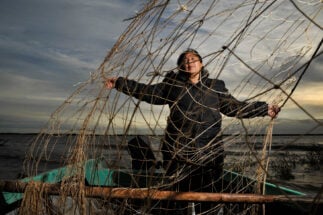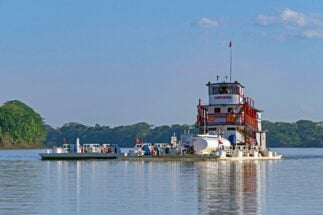Argentina, one of the world’s leading food producers, has yet to finalise the future administration of its section of the Paraná–Paraguay waterway, the route through which most of its exports pass.
What is being discussed specifically is how the dredging, signalling and maintenance services of the waterway will be carried out after the expiry in 2021 of the contract with its long-time concessionaire, Hidrovía SA, an alliance between Argentine company Emepa and Belgian firm Jan de Nul. At this point, the administration will either remain in state hands, or a new call for tenders will be issued, in which the participation of large international companies is expected.
The outcome will be crucial as, among other aspects, it will provide certainty over the execution of works that will reduce navigation times and lower logistical costs. At the same time, it may clear up doubts that have arisen among environmentalists, who are demanding that their perspective be incorporated into this new stage of the waterway’s management.
Paraná–Paraguay waterway: A river highway
The Paraná–Paraguay waterway is a river route formed by the Paraguay, Paraná and La Plata rivers, which covers an immense basin extending from the Bolivian highlands and Brazil’s Mato Grosso state, across Paraguay and northern Argentina to the Atlantic Ocean. It stretches more than 3,400 kilometres and crosses the largest agri-food production area in the Mercosur trading bloc.

As a navigation system that integrates transport and logistics services, the waterway has a short history. Although it dates back to 1969, when a first treaty was signed between Argentina, Brazil, Bolivia, Paraguay and Uruguay, it became more important in the 1990s.
The management of the waterway in Argentina underwent a substantial change in 1995, when permission for dredging and the creation of a beacon system along the route was granted, which substantially increased the depth of the rivers, allowing the entry of larger vessels and unprecedented port development.
This was a turning point for Argentina’s agro-industrial development, to the point that exports of grains, oils and related products tripled in little more than two decades, from 29 million tonnes in 1995 to 100 million tonnes in 2021.
Past, present and future
According to Juan Carlos Venesia, director of the Institute for Regional Development (IDR), a foundation based in Rosario, the decisions taken in the mid-1990s “allowed Argentina to become, within broader Mercosur, the country with the highest growth in the oilseed industry in the last 20 years.”
According to BCR data accessed by Diálogo Chino, the ships that currently operate on the waterway can carry between 46,000 and 48,000 tonnes of merchandise. If planned works are carried out, it would open up the possibility of larger types of ships that can carry between 65,000 and 70,000 tonnes operating on the waterway.
The waterway allowed Argentina to become the Mercosur country with the highest growth in the oilseed industry in the last 20 years
Gustavo Idigoras, president of the Chamber of the Oil Industry of the Argentine Republic and Cereal Export Centre (CIARA-CEC), said that the deepening of the waterway through dredging “would allow ships of greater draught to enter, which would reduce costs and would imply giving access to the sea to producers from Argentine regions that today do not have access to it due to economic reasons.”
The Argentine government shares the view of the private sector, with transport minister Alexis Guerrera recently saying the state is “obliged to update [the waterway] ourselves”. But it has demonstrated difficulties in implementing these plans.
In August 2021, the National Entity for the Control and Management of the Paraná–Paraguay Waterway was created, as the body responsible for overseeing the call for tenders for this new era. Recently, the head of the agency publicly announced that there could be a draft of the tender before the end of the year, but both locals and outsiders are doubtful. “There will possibly be some kind of rescheduling of the timetable,” said CIARA-CEC’s Idígoras.

Until there are new developments, the management of the waterway remains in the hands of the General Administration of Ports (AGP), a public body which, lacking its own capacities, subcontracts dredging and beacon services.
The AGP tried earlier this year to put the dredging out to tender on a temporary basis, but cancelled the process in the face of criticism from one of the bidders, who took the case to court. The complaint was made by the Unión Transitoria (UT), a consortium made up of the Belgian company Dredging International, the Argentine company Servimagnus and Shanghai Dredging Corporation – a subsidiary of the state-owned China Communications Construction Company. The group’s bid had been rejected in the technical evaluation stage.
Diálogo Chino covered the Chinese interest in the waterway in 2020, as the concession’s expiration loomed. Such interest is expected to remain strong when the tender for the future management of the waterway is eventually launched. A limited number of actors with a strong presence in international waters, mainly from European countries (Belgium, The Netherlands and Denmark), are bidding in this race.
Warnings
Every time the issue has been on the public agenda, environmentalists have demanded an evaluation of the impact of the changes brought upon the waterway since 1995, and have demanded that their perspective be incorporated into the new stage.
The global network Wetlands International described the end of the contract with Hidrovía SA as representing “an opportunity” to evaluate the socio-environmental impacts, and proposed a strategic evaluation to analyse the project’s impacts in the wetlands of the Paraná River, said to be “one of the last in South America”.

Local environmental organisations CAUCE and Taller Ecologista told the government that the impact studies carried out in the 1990s had “a strong economic bias, largely ignoring the socio-environmental impacts and mitigation costs associated with the project.”
The reports submitted by environmental organisations to the Federal Waterway Council show direct and indirect impacts of the activity on the waterway. From the potential alteration of the hydrological characteristics of the basin to the expansion of the agricultural frontier, the organisations do not hesitate to affirm that “the entry and greater number of vessels navigating the river notoriously harm biodiversity.”
The companies involved in the waterway reject the accusations and state that the environmental effects are “not significant”, in the words of the BCR’s Alfredo Sesé.
For its part, through the Ministry of Transport, the state has signed a series of agreements with national universities for further reports, audits and technical opinions useful for the control and prevention of environmental impacts in the management of the waterway. These agreements seem to incorporate some of the demands of civil society organisations, which are constantly demanding greater citizen participation and a more interdisciplinary approach to feasibility studies.
A spokesperson at the ministry of the Environment of the province of Santa Fe told Dialogo Chino that “it will be obligatory for the works planned under the new concession to have environmental impact studies”, which will have common criteria and standards among different jurisdictions. Given the proximity and interaction with various wetlands, it is said to be “fundamental” that the works be developed through “sustainable processes, taking into account the context of anthropic variability and climate change”.
The questions raised around environmental issues hang, in part, in the same limbo as those raised by the business sector: until the tender documents are published and the details of the future operation of the waterway are known, uncertainty will remain.








